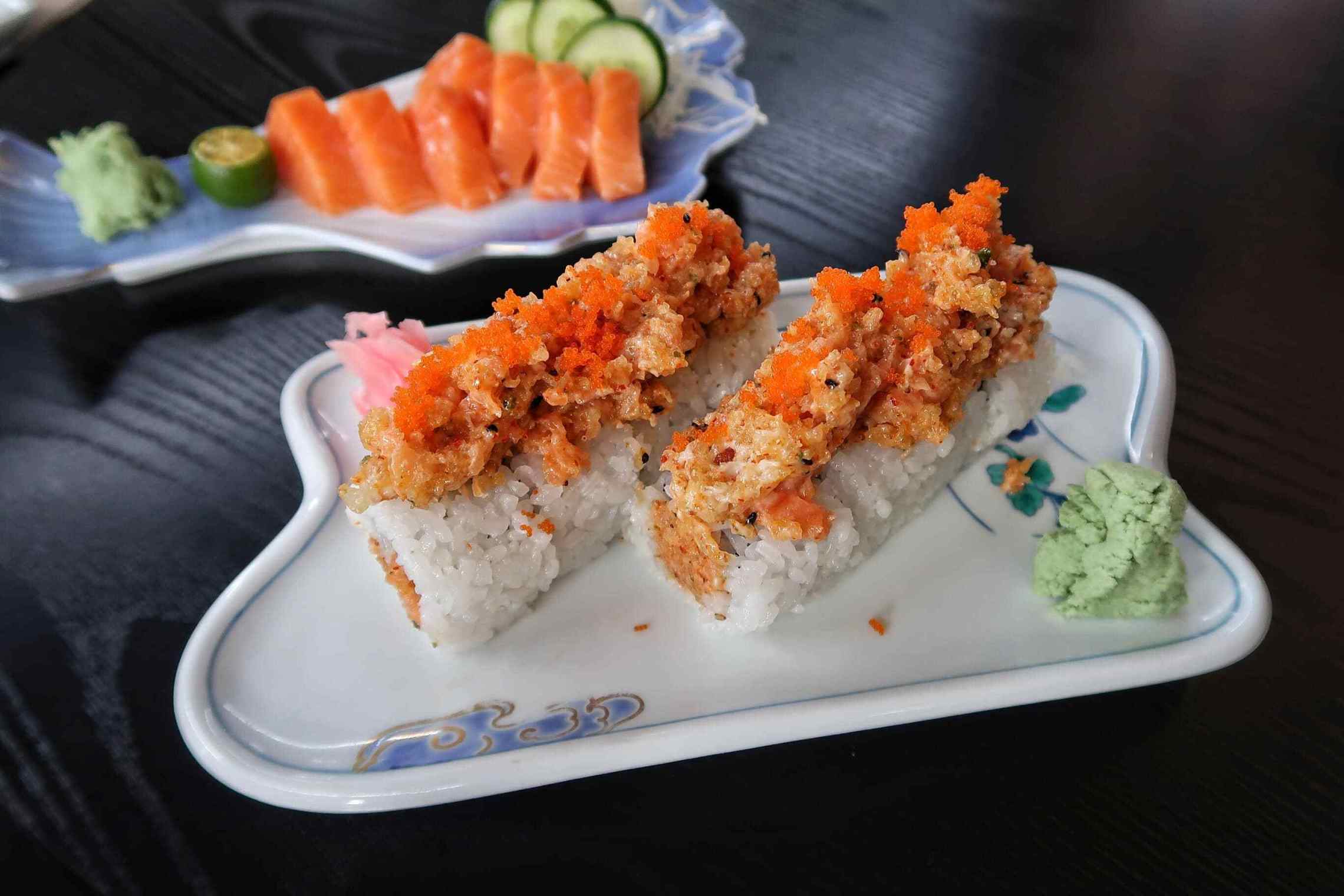A Journey Through the World of Sushi Rolls: From History to Homemade Delights
Related Articles
- A Journey Into The Heart Of America: Exploring The World Of Clam Chowder
- A Journey Through The Melting Pot: Exploring The World Of Swiss Fondue
- How To Make Plant-Based Sushi At Home: A Guide To Sustainable Seafood Alternatives
- A Culinary Journey Through Time: Unveiling The Delights Of Kimbap
- A Culinary Journey Through Provence: Exploring The Art Of Ratatouille
Introduction
Discover everything you need to know about A Journey Through the World of Sushi Rolls: From History to Homemade Delights
A Journey Through the World of Sushi Rolls: From History to Homemade Delights

Sushi, the iconic Japanese cuisine, has captivated taste buds worldwide with its vibrant flavors, delicate textures, and artistic presentation. While the image of perfectly crafted sushi rolls might seem intimidating to the home cook, fear not! This article will guide you on a delicious journey through the world of sushi, unveiling its history, exploring essential techniques, and providing step-by-step recipes for crafting your own culinary masterpieces.
A Culinary History: From Humble Beginnings to Global Phenomenon
The story of sushi is a fascinating journey through time and culinary evolution. It’s not about raw fish alone, but a testament to human ingenuity and adaptation in the face of limited resources.
The Roots of Narezushi: The story begins centuries ago, with narezushi, a fermented fish dish considered the ancestor of modern sushi. In ancient Japan, where refrigeration was non-existent, people sought ways to preserve fish. They would layer fish with salt and rice, allowing the lactic acid produced by the rice to ferment and preserve the fish. This process could take months, resulting in a pungent, salty, and acidic dish.
The Rise of Nigirizushi: Fast forward to the 18th century, and we see the emergence of nigirizushi, a more refined form of sushi. Edo, the bustling capital of Japan at the time, saw the rise of street vendors selling small hand-pressed rice balls topped with a slice of raw fish. This innovation was driven by the need for faster preparation and a more palatable flavor.
The Modern Era: Sushi Goes Global: The 20th century witnessed the globalization of sushi. The invention of the sushi conveyor belt in the 1950s revolutionized the dining experience, making sushi more accessible and enjoyable. As sushi gained popularity, innovative chefs began experimenting with different ingredients and techniques, leading to the diverse range of sushi rolls we see today.
The Essence of Sushi: Understanding the Ingredients and Techniques
Crafting delicious sushi is a blend of art and science. Understanding the fundamental ingredients and techniques is crucial to achieving success.
1. The Rice: The Foundation of Sushi:
- Choosing the Right Rice: The key to perfect sushi rice is selecting the right variety. Japanese short-grain rice is essential, known for its stickiness and ability to hold its shape. Look for varieties like Koshihikari or Nishiki for optimal results.
- Washing and Soaking: Rinse the rice thoroughly until the water runs clear, removing excess starch. This helps prevent stickiness and ensures a fluffy texture. Soak the rice in fresh water for 30 minutes before cooking.
- Cooking the Rice: Use a rice cooker or a saucepan for cooking. The ratio of water to rice is crucial. For most rice cookers, the recommended ratio is 1:1. For stovetop cooking, use a slightly higher ratio, around 1:1.2.
- Seasoning the Rice: After cooking, gently fluff the rice with a rice paddle. While it’s still warm, season it with sushi vinegar. This mixture typically includes rice vinegar, sugar, and salt. The precise proportions may vary, but the goal is to achieve a slightly sweet and tangy flavor.

2. The Fish: The Star of the Show:
- Freshness is Key: The quality of your fish is paramount. Opt for fresh, high-quality seafood from reputable sources. Fresh fish should have a bright, clear eye, firm flesh, and a pleasant, clean smell.
- Types of Fish: Sushi is traditionally made with a variety of fish, including tuna (maguro), salmon (sake), yellowtail (hamachi), sea bass (tai), and mackerel (saba). These fish offer distinct flavors and textures, adding diversity to your sushi experience.
- Sashimi-Grade Fish: For sushi, choose sashimi-grade fish, meaning it has been inspected and deemed safe for consumption raw. This ensures that the fish has been properly handled and is free from parasites.
3. The Seaweed: Adding Flavor and Texture:
- Nori: The Essential Wrap: Nori is a type of dried seaweed that serves as the wrapper for sushi rolls. It adds a subtle salty and umami flavor, contributing to the overall taste and texture.
- Choosing Quality Nori: Look for nori sheets that are dark green and have a glossy, smooth surface. Avoid sheets that are brittle or have a dull appearance.

4. The Fillings: Adding Creativity and Flavor:
- Traditional Fillings: Classic sushi rolls often feature vegetables like cucumber, avocado, and daikon radish for a refreshing crunch. Crab meat, shrimp, and eggs are also popular choices.
- Creative Fillings: Don’t be afraid to experiment! Explore a world of possibilities with spicy mayo, pickled ginger, and even grilled meats. The possibilities are endless!
5. The Tools: Essential Equipment for Sushi Making:
- Sushi Rolling Mat (Makisu): A bamboo mat used for rolling sushi rolls. It provides structure and helps create a tight, even roll.
- Sharp Knife: A sharp knife is essential for slicing fish and vegetables thinly and precisely.
- Rice Paddle: A wooden paddle used to gently fluff and season the rice.
- Sushi Vinegar: A mixture of rice vinegar, sugar, and salt used to season the sushi rice.
- Small Bowls: For holding ingredients and sauces.
Mastering the Art of Sushi Rolling: Techniques for Perfect Rolls
Now that we’ve explored the essential ingredients and tools, let’s delve into the techniques for rolling perfect sushi rolls.
1. Preparing the Rice:
- Seasoning the Rice: After cooking, gently fluff the rice with a rice paddle. While it’s still warm, season it with sushi vinegar. Use a rice paddle to gently mix the vinegar into the rice.
- Cooling the Rice: Allow the rice to cool slightly before using. It should be warm but not hot.
2. Assembling the Sushi Roll:
- Laying the Nori: Place a sheet of nori on a sushi rolling mat.
- Adding the Rice: Spread a thin layer of rice evenly over the nori, leaving a small margin at the top.
- Adding the Fillings: Arrange your chosen fillings in a line down the center of the rice.
- Rolling the Sushi: Gently lift the bottom edge of the nori, rolling it over the fillings. Use the mat to help guide the roll, applying gentle pressure to create a tight, compact roll.
- Finishing the Roll: Once rolled, moisten the top edge of the nori with a little water to seal the roll.
3. Slicing and Serving:
- Slicing the Roll: Use a sharp knife to slice the roll into even pieces. Dip the knife in water between slices to prevent sticking.
- Serving the Sushi: Arrange the sliced sushi on a plate, garnishing with pickled ginger (gari) and wasabi. Serve with soy sauce and chopsticks.
Sushi Roll Recipes: A Culinary Journey Through Flavor
Now that we’ve covered the basics, let’s dive into some delicious sushi roll recipes that will tantalize your taste buds.
1. Classic California Roll:
Ingredients:
- 1 cup sushi rice
- 1 sheet nori
- 1/2 avocado, thinly sliced
- 1/4 cup imitation crab meat, shredded
- 1/4 cucumber, thinly sliced
- 1 tablespoon mayonnaise
- Sesame seeds (for garnish)
Instructions:
- Prepare the sushi rice according to the instructions above.
- Place a sheet of nori on a sushi rolling mat.
- Spread a thin layer of rice evenly over the nori, leaving a small margin at the top.
- Turn the nori over so the rice side is facing down.
- Spread a thin layer of mayonnaise along the center of the rice.
- Arrange the avocado, crab meat, and cucumber slices in a line down the center of the rice.
- Gently lift the bottom edge of the nori, rolling it over the fillings. Use the mat to help guide the roll, applying gentle pressure to create a tight, compact roll.
- Once rolled, moisten the top edge of the nori with a little water to seal the roll.
- Slice the roll into 8 even pieces.
- Garnish with sesame seeds and serve with soy sauce, wasabi, and pickled ginger.
2. Spicy Tuna Roll:
Ingredients:
- 1 cup sushi rice
- 1 sheet nori
- 1/2 cup raw tuna, thinly sliced
- 1 tablespoon sriracha sauce
- 1 tablespoon mayonnaise
- 1/4 avocado, thinly sliced
- Sesame seeds (for garnish)
Instructions:
- Prepare the sushi rice according to the instructions above.
- Place a sheet of nori on a sushi rolling mat.
- Spread a thin layer of rice evenly over the nori, leaving a small margin at the top.
- Turn the nori over so the rice side is facing down.
- Combine the sriracha sauce and mayonnaise in a small bowl.
- Spread the spicy mayo mixture along the center of the rice.
- Arrange the tuna and avocado slices in a line down the center of the rice.
- Gently lift the bottom edge of the nori, rolling it over the fillings. Use the mat to help guide the roll, applying gentle pressure to create a tight, compact roll.
- Once rolled, moisten the top edge of the nori with a little water to seal the roll.
- Slice the roll into 8 even pieces.
- Garnish with sesame seeds and serve with soy sauce, wasabi, and pickled ginger.
3. Rainbow Roll:
Ingredients:
- 1 cup sushi rice
- 1 sheet nori
- 1/4 cup avocado, thinly sliced
- 1/4 cucumber, thinly sliced
- 1/4 cup imitation crab meat, shredded
- 1/4 cup raw tuna, thinly sliced
- 1/4 cup raw salmon, thinly sliced
- 1/4 cup raw yellowtail, thinly sliced
- Sesame seeds (for garnish)
Instructions:
- Prepare the sushi rice according to the instructions above.
- Place a sheet of nori on a sushi rolling mat.
- Spread a thin layer of rice evenly over the nori, leaving a small margin at the top.
- Turn the nori over so the rice side is facing down.
- Arrange the avocado, cucumber, and crab meat slices in a line down the center of the rice.
- Top the fillings with a row of tuna, then salmon, and finally yellowtail, creating a colorful rainbow effect.
- Gently lift the bottom edge of the nori, rolling it over the fillings. Use the mat to help guide the roll, applying gentle pressure to create a tight, compact roll.
- Once rolled, moisten the top edge of the nori with a little water to seal the roll.
- Slice the roll into 8 even pieces.
- Garnish with sesame seeds and serve with soy sauce, wasabi, and pickled ginger.
4. Philadelphia Roll:
Ingredients:
- 1 cup sushi rice
- 1 sheet nori
- 1/2 avocado, thinly sliced
- 1/4 cup cream cheese
- 1/4 cup smoked salmon, thinly sliced
- 1/4 cucumber, thinly sliced
- Sesame seeds (for garnish)
Instructions:
- Prepare the sushi rice according to the instructions above.
- Place a sheet of nori on a sushi rolling mat.
- Spread a thin layer of rice evenly over the nori, leaving a small margin at the top.
- Turn the nori over so the rice side is facing down.
- Spread a thin layer of cream cheese along the center of the rice.
- Arrange the avocado, cucumber, and smoked salmon slices in a line down the center of the rice.
- Gently lift the bottom edge of the nori, rolling it over the fillings. Use the mat to help guide the roll, applying gentle pressure to create a tight, compact roll.
- Once rolled, moisten the top edge of the nori with a little water to seal the roll.
- Slice the roll into 8 even pieces.
- Garnish with sesame seeds and serve with soy sauce, wasabi, and pickled ginger.
5. Dragon Roll:
Ingredients:
- 1 cup sushi rice
- 1 sheet nori
- 1/2 avocado, thinly sliced
- 1/4 cup imitation crab meat, shredded
- 1/4 cucumber, thinly sliced
- 1/4 cup eel, grilled and sliced
- 1 tablespoon unagi sauce
- Sesame seeds (for garnish)
Instructions:
- Prepare the sushi rice according to the instructions above.
- Place a sheet of nori on a sushi rolling mat.
- Spread a thin layer of rice evenly over the nori, leaving a small margin at the top.
- Turn the nori over so the rice side is facing down.
- Arrange the avocado, cucumber, and crab meat slices in a line down the center of the rice.
- Top the fillings with a row of grilled eel, creating a dragon-like appearance.
- Drizzle a thin layer of unagi sauce over the eel.
- Gently lift the bottom edge of the nori, rolling it over the fillings. Use the mat to help guide the roll, applying gentle pressure to create a tight, compact roll.
- Once rolled, moisten the top edge of the nori with a little water to seal the roll.
- Slice the roll into 8 even pieces.
- Garnish with sesame seeds and serve with soy sauce, wasabi, and pickled ginger.
Tips for Sushi Success: Elevating Your Culinary Game
1. Mastering the Rice:
- Temperature is Key: The temperature of the rice is crucial for successful sushi making. It should be warm but not hot, allowing it to be molded without becoming sticky.
- Seasoning with Care: The amount of sushi vinegar used will affect the overall flavor of the rice. Start with a smaller amount and adjust to your taste.
- Using a Rice Paddle: Gently fluffing the rice with a rice paddle helps create a light and airy texture.
2. Choosing the Right Fish:
- Freshness is Paramount: Always opt for fresh, high-quality fish. Look for fish with a bright, clear eye, firm flesh, and a pleasant, clean smell.
- Sashimi-Grade is Essential: For sushi, it’s essential to use sashimi-grade fish, which has been inspected and deemed safe for consumption raw.
- Variety is Key: Experiment with different types of fish to discover your favorites. Each fish offers unique flavors and textures.
3. Handling the Nori:
- Quality Matters: Choose nori sheets that are dark green and have a glossy, smooth surface. Avoid sheets that are brittle or have a dull appearance.
- Moistening the Nori: Lightly moistening the edge of the nori with water helps seal the roll, preventing it from unraveling.
4. Rolling Techniques:
- Tight and Even Rolls: Aim for tight, even rolls with a consistent shape. This ensures that the fillings are evenly distributed.
- Using the Mat: The sushi rolling mat provides structure and support, helping you create neat and uniform rolls.
- Practice Makes Perfect: Like any culinary skill, sushi rolling takes practice. Don’t be discouraged if your first attempts aren’t perfect.
5. Serving Sushi:
- Presentation Matters: Arrange the sliced sushi on a plate in a visually appealing way.
- Garnishing with Care: Garnish with pickled ginger (gari) and wasabi, adding both flavor and visual appeal.
- Serving with Soy Sauce: Serve soy sauce, chopsticks, and a small dish of wasabi alongside the sushi.
Beyond the Basics: Exploring the World of Sushi
The world of sushi is vast and diverse, offering endless possibilities for culinary exploration. Here are some additional aspects to consider:
1. Different Types of Sushi:
- Nigiri: Hand-pressed rice topped with a slice of fish or other ingredients.
- Maki: Sushi rolls, where ingredients are wrapped in nori.
- Temaki: Hand-rolled cones of nori filled with ingredients.
- Inarizushi: Sushi rice stuffed into seasoned deep-fried tofu pockets.
- Chirashizushi: A bowl of sushi rice topped with various ingredients.
2. Creative Fillings:
- Spicy Mayo: A popular addition to many sushi rolls, adding a kick of heat.
- Pickled Ginger (Gari): A refreshing palate cleanser served alongside sushi.
- Wasabi: A pungent, green horseradish paste that adds a powerful flavor.
- Grilled Meats: Explore the addition of grilled meats like beef or chicken to your sushi creations.
- Fruits: Experiment with sweet and tangy fruits like mango or pineapple for a unique twist.
3. Beyond Traditional Sushi:
- Sushi Burrito: A fusion dish combining sushi ingredients in a burrito-style wrap.
- Sushi Pizza: A creative take on sushi, where ingredients are arranged on a rice base.
- Sushi Bowls: A deconstructed version of sushi, with ingredients served in a bowl over rice.
4. Sushi Etiquette:
- Chopsticks: Sushi is traditionally eaten with chopsticks.
- Soy Sauce: Dip the fish side of the sushi into soy sauce, not the rice.
- Wasabi: A small amount of wasabi can be added to soy sauce or placed directly on the sushi.
- Pickled Ginger (Gari): Eat a small piece of pickled ginger between bites to cleanse the palate.
5. Sushi at Home vs. Restaurants:
- Home-Made Advantages: Sushi making at home offers a fun and creative culinary experience, allowing you to customize your rolls with your favorite ingredients.
- Restaurant Experience: Sushi restaurants provide a professional and authentic dining experience, offering a wide variety of sushi rolls and expertly prepared dishes.
Conclusion: Embark on Your Sushi Journey
The world of sushi is a delicious and fascinating journey, offering a vibrant fusion of flavors, textures, and artistic presentation. Whether you’re a seasoned sushi aficionado or a curious beginner, this article has provided you with the knowledge and inspiration to embark on your own
Closure
Thank you for reading! Stay with us for more insights on A Journey Through the World of Sushi Rolls: From History to Homemade Delights.
Don’t forget to check back for the latest news and updates on A Journey Through the World of Sushi Rolls: From History to Homemade Delights!
Feel free to share your experience with A Journey Through the World of Sushi Rolls: From History to Homemade Delights in the comment section.
Stay informed with our next updates on A Journey Through the World of Sushi Rolls: From History to Homemade Delights and other exciting topics.





